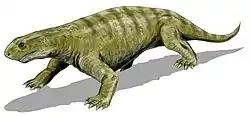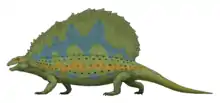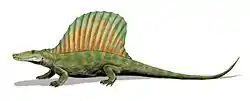Alierasaurus
Alierasaurus is an extinct genus of caseid synapsid that lived during the early Middle Permian (Roadian)[1] in what is now Sardinia.[2] It is represented by a single species, the type species Alierasaurus ronchii. Known from a very large partial skeleton found within the Cala del Vino Formation, Alierasaurus is one of the largest known caseids. It closely resembles Cotylorhynchus, another giant caseid from the Middle Permian San Angelo Formation in Texas. The dimensions of the preserved foot elements and caudal vertebrae suggest an estimated total length of about 6 or 7 m for Alierasaurus.[3][4][5] In fact, the only anatomical features that differ between Alierasaurus and Cotylorhynchus are found in the bones of the feet; Alierasaurus has a longer and thinner fourth metatarsal and it has ungual bones at the tips of the toes that are pointed and claw-like rather than flattened as in other caseids. Alierasaurus and Cotylorhynchus both have very wide, barrel-shaped rib cages indicating that they were herbivores that fed primarily on high-fiber plant material.[3]
| Alierasaurus | |
|---|---|
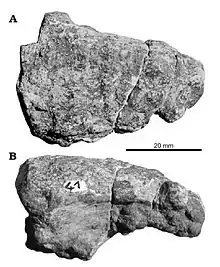 | |
| Claw | |
| Scientific classification | |
| Kingdom: | Animalia |
| Phylum: | Chordata |
| Clade: | †Caseasauria |
| Family: | †Caseidae |
| Genus: | †Alierasaurus Romano and Nicosia, 2014 |
| Species: | †A. ronchii |
| Binomial name | |
| †Alierasaurus ronchii Romano and Nicosia, 2014 | |
Etymology
The generic name refers to Aliera, the name in local dialect of the town of Alghero, and ‘saurus’ meaning lizard. The specific name is in honor of Ausonio Ronchi the discoverer of the specimen.[3]
Description
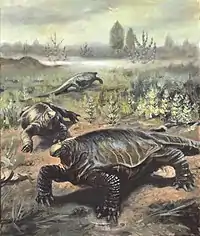
The paleontologists Marco Romano and Umberto Nicosia have identified several autapomorphies in the feet anatomy of Alierasaurus : metatarsal IV with distinct axial region, length about twice that of the corresponding proximal phalanx, not short and massive as in other large caseids; metatarsal IV proximal head not orthogonal to the bone axis, forming an angle of 120° with the shaft: with this conformation, the proximal and distal heads are much closer along the medial side of the metatarsal; claw-shaped ungual phalanges proportionally shorter than in Cotylorhynchus, with a double ventral flexor tubercle very close to the proximal rim of the phalanx; ungual phalangeal axis bent downward and medially; distal transverse section subtriangular, not spatulate as in Cotylorhynchus.[3]
Discovery
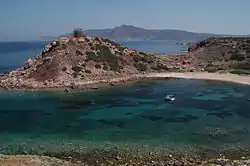
The holotype of Alierasaurus was discovered in the uppermost levels of the Permian Cala del Vino Formation, on top of the Torre del Porticciolo promontory, which separates the Porticciolo Gulf from the northern coast (near the town of Alghero, Nurra, northwest Sardinia).[2] Some bones were found loose on the ground surface, and others still embedded in mudstone-siltstone layer. These sediments were deposited in a former alluvial plain under a relatively mild semi-arid climate.[2] The known material consist of eight articulated caudal vertebrae, two isolated caudal vertebrae, four distal caudal centra, numerous large fragments referable to at least eight other vertebrae, seven proximal portions of hemal arches, three proximal portions (vertebral segment) of dorsal ribs, ten undetermined fragmentary ribs, poorly preserved right scapula and badly crushed right coracoid plate, distal head of the left ulna, and several autopodial elements represented by a fragmentary calcaneum, three metapodials, five non-ungual phalanges, an almost complete ungual phalanx, and two ungual phalanges lacking distal ends.[3] These remains were firstly regarded as belonging possibly to Cotylorhynchus (cf Cotylorhynchus sp. in the publication of Ronchi et al.) or to a closely related taxon. Later, despite the absence of the most diagnostic elements (notably the skull) for the comparison with other caseids in general and with Cotylorhynchus in peculiar, the Sardinian specimen was assigned to a new genus named Alierasaurus, on the basis of some differences in feet anatomy.[2][3] In 2017, Marco Romano and colleagues described other bones belonging to the same individual (some caudal vertebrae and fragments of chevrons and ribs).[4] More recently, the same levels have yielded remains of an undescribed sphenacodontid pelycosaur, and footprints of a third animal which was only known in the south of France in slightly younger rocks (ichnogenus Merifontichnus from the La Lieude Formation (Wordian) in the Lodève basin).[5][1]
References
- Citton, P.; Ronchi, A.; Maganuco, S.; Caratelli, M.; Nicosia, U.; Sacchi, E.; Romano, M. (2018). "First tetrapod footprints from the Permian of Sardinia and their palaeontological and stratigraphical significance". Geological Journal: 1–15. doi:10.1002/gj.3285.
- Ronchi, A.; Sacchi, E.; Romano, M.; Nicosia, U. (2011). "A huge caseid pelycosaur from north-western Sardinia and its bearing on European Permian stratigraphy and palaeobiogeography". Acta Palaeontologica Polonica. 56 (4): 723–738. doi:10.4202/app.2010.0087.
- Romano, M.; Nicosia, U. (2014). "Alierasaurus ronchii, gen. et sp. nov., a caseid from the Permian of Sardinia, Italy". Journal of Vertebrate Paleontology. 34 (4): 900–913. doi:10.1080/02724634.2014.837056.
- Romano, M.; Ronchi, A.; Maganuco, S.; Nicosia, U (2017). "New material of Alierasaurus ronchii (Synapsida, Caseidae) from the Permian of Sardinia (Italy), an dits phylogenetic affinities". Palaeontologia Electronica. 20.2.26A: 1–27. doi:10.26879/684.
- Romano, M.; Citton, P.; Maganuco, S.; Sacchi, E.; Caratelli, M.; Ronchi, A.; Nicosia, U. (2018). "New basal synapsid discovery at the Permian outcrop of Torre del Porticciolo (Alghero, Italy)". Geological Journal: 1–13. doi:10.1002/gj.3250.
